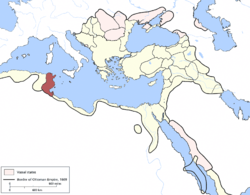Tunis Province, Ottoman Empire
| Eyalet of Tunis | ||||||||||
| Eyalet of the Ottoman Empire | ||||||||||
|
||||||||||
|
The Eyalet of Tunis in 1609
|
||||||||||
| Capital | Tunis | |||||||||
| Languages | Tunisian Arabic, Ottoman Turkish, Judeo-Tunisian Arabic, Domari | |||||||||
| Religion | Sunni Islam, Judaism | |||||||||
| Government | Monarchy | |||||||||
| History | ||||||||||
| • | Established | 13 September 1574 | ||||||||
| • | Beylik | 15 July 1705 | ||||||||
| Currency | Tunisian rial | |||||||||
|
||||||||||
| Today part of |
|
|||||||||
Ottoman Tunis refers to the episode of the Turkish presence in Ifriqiya during the course of three centuries from the 16th century until the 18th century, when Tunis was officially integrated into the Ottoman Empire as the Eyalet of Tunis (province). Eventually including all of the Maghrib except Morocco, the Ottoman Empire began with the takeover of Algiers in 1516 by the Ottoman Turkish corsair and beylerbey Oruç Reis. The first Ottoman conquest of Tunis took place in 1534 under the command of Barbarossa Hayreddin Pasha, the younger brother of Oruç Reis, who was the Kapudan Pasha of the Ottoman Fleet during the reign of Suleiman the Magnificent. However, it wasn't until the final Ottoman reconquest of Tunis from Spain in 1574 under Kapudan Pasha Uluç Ali Reis that the Turks permanently acquired the former Hafsid Tunisia, retaining it until the French occupation of Tunisia in 1881.
Initially under Turkish rule from Algiers, soon the Ottoman Porte appointed directly for Tunis a governor called the Pasha supported by janissary forces. Before long, however, Tunisia became in effect an autonomous province, under the local Bey. This evolution of status was from time to time challenged without success by Algiers. During this era the governing councils controlling Tunisia remained largely composed of a foreign elite who continued to conduct state business in the Ottoman Turkish language.
...
Wikipedia


